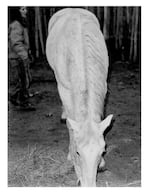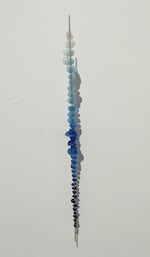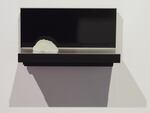Memories can sometimes be vivid or distant and difficult to articulate.
A show now on view called "The Color of Memory" at Jeffrey Thomas Fine Art in Northwest Portland addresses issues of memory through the work of 16 West Coast artists who Thomas selected for their intense use or rejection of color in their work.
Though many of the artists in the show interpret color through traditional styles of painting, there are others who express it through installation art and even bypass color altogether.
"Since I work in black and white, the first thing that I think of is an absence," said photographer and Portland State professor Doug Lowell, who has two works in the show.
One, titled “Horse” is dominated by a ghostly pale horse with its neck bent, grazing. Spend some time with it, and you’ll notice the spectral human figure in the background.

"Horse" is one of the black and white photos Lowell has in Thomas's show.
Photo courtesy of Doug Lowell.
Lowell describes it as “a slightly mythological creature performing some kind of feat of transformation accompanied by a disappearing figure who, [was] Elizabeth my sister.”
Lowell says his sister turned out to be an important choice for the picture.
“While I was shooting this, she had stage 4 colon cancer and yes, sure enough, she did die,” he said.
He says this series was informed by his close reading of English poet William Blake and Blake’s grasp of mortality.
Lowell chose to oddly crop the photos so that viewers were presented with fragmented glimpses of what was going on behind the frame.
“I really like things that look like they are mistakes because there is usually something new in that," Lowell said.
There are also more traditional artists in the show who use lots of color.
Ellen George is a Portland-based artist who makes vertical wall pieces and sculpture. Her piece is titled "Pacific Blue."
“I didn’t start out to make a piece about the ocean, it actually came the other way from the other direction,” she said.

Ellen George's vertical wall sculpture "Pacific Blue" uses polymer orbs that illustrates the varying intensities of blue.
Jon Williams/OPB.
The piece features a metal rod stacked with polymer orbs in many shades of blue, hanging flush against the wall.
George says, in her memory, color is closely tied to qualities of light, sometimes a certain kind of shimmer or reflection.
Thomas says he started thinking about color and memory while looking at a nightmarish painting by the twentieth century painter Jon Serl. It’s like a dream, but with vivid colors.
“When most of us think of colors, memory of great colors, we are going to be thinking of sunsets we’ve seen and we’re going to be thinking about sunrises we have endured. You just go on Instagram on any given hour and you’re going to see that,” Thomas said.
So, he thought, how do artists think about color and the passage of time?
While our emotional responses to color are strong, some artists in the show skipped the obvious choices.
Installation artist Laura Fritz built a sleek black mantel. On it, she places a small, translucent object about the size and shape of a child's retainer that lies slightly off center. The piece is titled "Spektive."

Installation artist Laura Fritz's piece titled "Spektive" plays with light, color and perspective.
Photo courtesy of Laura Fritz.
“I like to present a stripped down situation that leaves a lot of room for the viewer to try to figure out what is going on. These are really uncertain times and a lot of my work studies how people react to those kinds of situations and how they try to put the pieces together, which is often referred to as 'apophenia,'” Fritz said.
Apophenia is a scientific term that refers to the feeling you get when you start to see connections among seemingly unrelated things. It’s not unrelated to how Fritz produces art in her studio.
“I’ll just play around with different ideas and different combinations of materials to cast and different layers of color,” she said.
For Fritz, the Color of Memory is fluid: what you remember about color can sometimes change. Take the work she submitted for this show.
“I had made that piece a few years ago and I was thinking about it for this show, but because I remembered it slightly different color-wise I couldn’t find it in my studio," she said. "And it was driving me crazy until I realized, oh it’s right here because I remembered it as a weird greenish color but it’s actually more yellow.”
The Color of Memory will be on view at Thomas’s gallery through Aug. 27.